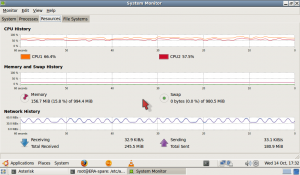 Following the release of the new 9.10 ‘Karmic Koala’ version of Ubuntu, we installed it on one of the Asus 901s, trying out a new configuration of all ext4 disk partitions and no swap partition. Discovering that the ‘Netbook Remix’ (UNR) release of the operating system now could only use the mobile phone look-alike interface and had the Desktop-Switcher package removed, we followed forum advice and tried the full Ubuntu 9.10 release instead. Having disabled the ‘wobbly windows’ graphics enhancements in Gnome, Ubuntu 9.10 was no trouble on the Asus 901 – all the devices worked from the start, dialogue and menu boxes fitted in the available screen area by default. One of the main reasons for trying Ubuntu 9.10 was to experiment with an early desire of ERA to use the bluetooth audio headsets commonly available for mobile phones instead of wired mic-and-headphones devices. With our Ubuntu 9.04 UNR installations we couldn’t get this to work, despite spending a frustrating day or two in early July with the latest software then available. At that time, improved bluetooth interaction with beta Pulseaudio releases and experimental device control with Blueman were not integrated into Ubuntu releases, but promised to make bluetooth audio as simple under Ubuntu as it is on a mobile phone.
Following the release of the new 9.10 ‘Karmic Koala’ version of Ubuntu, we installed it on one of the Asus 901s, trying out a new configuration of all ext4 disk partitions and no swap partition. Discovering that the ‘Netbook Remix’ (UNR) release of the operating system now could only use the mobile phone look-alike interface and had the Desktop-Switcher package removed, we followed forum advice and tried the full Ubuntu 9.10 release instead. Having disabled the ‘wobbly windows’ graphics enhancements in Gnome, Ubuntu 9.10 was no trouble on the Asus 901 – all the devices worked from the start, dialogue and menu boxes fitted in the available screen area by default. One of the main reasons for trying Ubuntu 9.10 was to experiment with an early desire of ERA to use the bluetooth audio headsets commonly available for mobile phones instead of wired mic-and-headphones devices. With our Ubuntu 9.04 UNR installations we couldn’t get this to work, despite spending a frustrating day or two in early July with the latest software then available. At that time, improved bluetooth interaction with beta Pulseaudio releases and experimental device control with Blueman were not integrated into Ubuntu releases, but promised to make bluetooth audio as simple under Ubuntu as it is on a mobile phone.
Tag Archives: audio
MeetMe testing
Last Wednesday we did some testing of our Asterisk MeetMe setup, at dekspc medialab in London. Setting up the Asterisk server on the local wired LAN and assembling an assortment of 6 SIP clients, using Ekiga on both Windows and Linux platforms, and a Mac running the SIP client Telephone. Each client registered with Asterisk as users era1 -> era9 and dialled ‘1234’ for the MeetMe conference room. Continue reading
Set up Asterisk conference calling with MeetMe.
I made my first (2-way) conference call on Asterisk/Meetme just now. To enable MeetMe with Asterisk, you first need to edit your meetme.conf in /etc/asterisk/ , mine looks like this:
Sipdroid works on G1 Android 1.5
Good news sipdroid works with our Asterisk server. Following up on a lead I received from Ben Charlton at the JISCRI developers workshop last week, I tried running sipdroid on a borrowed G1 Android phone (big thanks to Paul Hogan). The default SipDroid pretty much works, but you need to set the nat setting in the Asterisk sip.conf file to yes (see sipdroid website – issue 15). No big deal but SipDroid does not authetnticate without it.
Once I got over the above registration issue, it was just a case of setting the Asterisk audio codecs to include alaw. Seems pretty OK – supports a steady audio stream. We could use this with a separate webpage displayed on the phone web browser for showing images and the video stream. Currently the SipDroid does not display a remote video and I was unable to get it to stream video from the phone within SipDroid, but audio is certainly doable.

